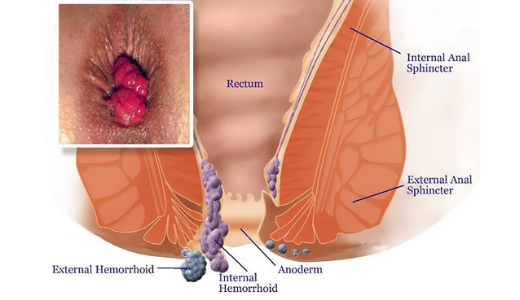Piles Clinic In Noida

Piles
What are piles (Hemorrhoids)?
Piles is another term for hemorrhoids. Hemorrhoids are collections of inflamed tissue in the anal canal. They contain blood vessels, support tissue, muscle, and elastic fibers. Many people have piles, but the symptoms are not always obvious. Hemorrhoids cause noticeable symptoms for at least 50 percent of people in the United States (U.S.) before the age of 50 years.
What are internal and external piles (hemorroids)?
Internal haemorrhoids lie inside the rectum and are difficult to see with naked eye or feel with hand. They don't usually hurt because there are less pain-sensing nerves in the rectum. Bleeding may be the only sign in many cases. Sometimes internal haemorrhoids prolapse or enlarge and protrude outside the anal sphincter. In that case it may be seen outside or felt with hand as moist, pink pads of skin that are pinker than the surrounding area. Prolapsed haemorrhoids may hurt because they become irritated by rubbing from clothing and sitting. They usually recede into the rectum on their own; it can be even gently pushed back into place.
External haemorrhoids lie within the anus and are often uncomfortable. If an external hemorrhoid prolapse to the outside (usually in the course of passing a stool), it can be seen or felt. Blood clots sometimes form within prolapsed external haemorrhoids, causing an extremely painful condition called a thrombosis. When the external hemorrhoid becomes thrombosed, it can look rather frightening, turning purple or blue, and could possibly bleed. Despite their appearance, thrombosed haemorrhoids are usually not serious and will resolve themselves in about a week. If the pain is unbearable, the thrombosed hemorrhoid can be removed with surgery, which stops the pain.
What are the symptoms of hemorroids?
Internal piles are usually painless. There may be a constant feeling of vague discomfort. When the piles are prolapsed, this discomfort is increased; there may be bright red rectal bleeding during or following defecation; there may be discharge of mucus and itching in the anus.
External piles often cause itching, burning and may cause bleeding. They are bluish colored masses of venous engorgement with severe pain and anal spasm. These are small lumps that are located on the outside edge of the anus. They are very itchy and can be painful if a blood clot forms inside (thrombosed external hemorrhoid).
What do and external and internal hemorrhoids look like?
Internal haemorrhoids: These can’t always be seen because they’re too deep in your anus to be visible. They are protrusions of the wall of your anal canal or rectum. Less-serious internal hemorrhoids are bumps inside, and more serious ones can form a long protrusion.
External haemorrhoids: Appear as one or more bumps on and around the anus. You or a doctor can see these from the outside.
What causes hemorrhoids?
The causes of hemorrhoids include
- straining during bowel movements
- sitting on the toilet for long periods of time
- chronic constipation or diarrhea
- a low-fiber diet
- weakening of the supporting tissues in your anus and rectum that happens with aging
- pregnancy
- often lifting heavy objects
What are symptoms and signs of hemorrhoids?
The symptoms of hemorrhoids depend on the type you have.
If you have external hemorrhoids, you may have
- anal itching
- one or more hard, tender lumps near your anus
- anal ache or pain, especially when sitting
Too much straining, rubbing, or cleaning around your anus may make your symptoms worse. For many people, the symptoms of external hemorrhoids go away within a few days.
If you have internal hemorrhoids, you may have
- bleeding from your rectum–bright red blood on stool, on toilet paper, or in the toilet bowl after a bowel movement
- a hemorrhoid that has fallen through your anal opening, called prolapse
Internal hemorrhoids that are not prolapsed most often are not painful. Prolapsed internal hemorrhoids may cause pain and discomfort.
Although hemorrhoids are the most common cause of anal symptoms, not every anal symptom is caused by a hemorrhoid. Some hemorrhoid symptoms are similar to those of other digestive tract problems. For example, bleeding from your rectum may be a sign of bowel diseases such as Crohns disease, ulcerative colitis, or cancer of the colon or rectum.









